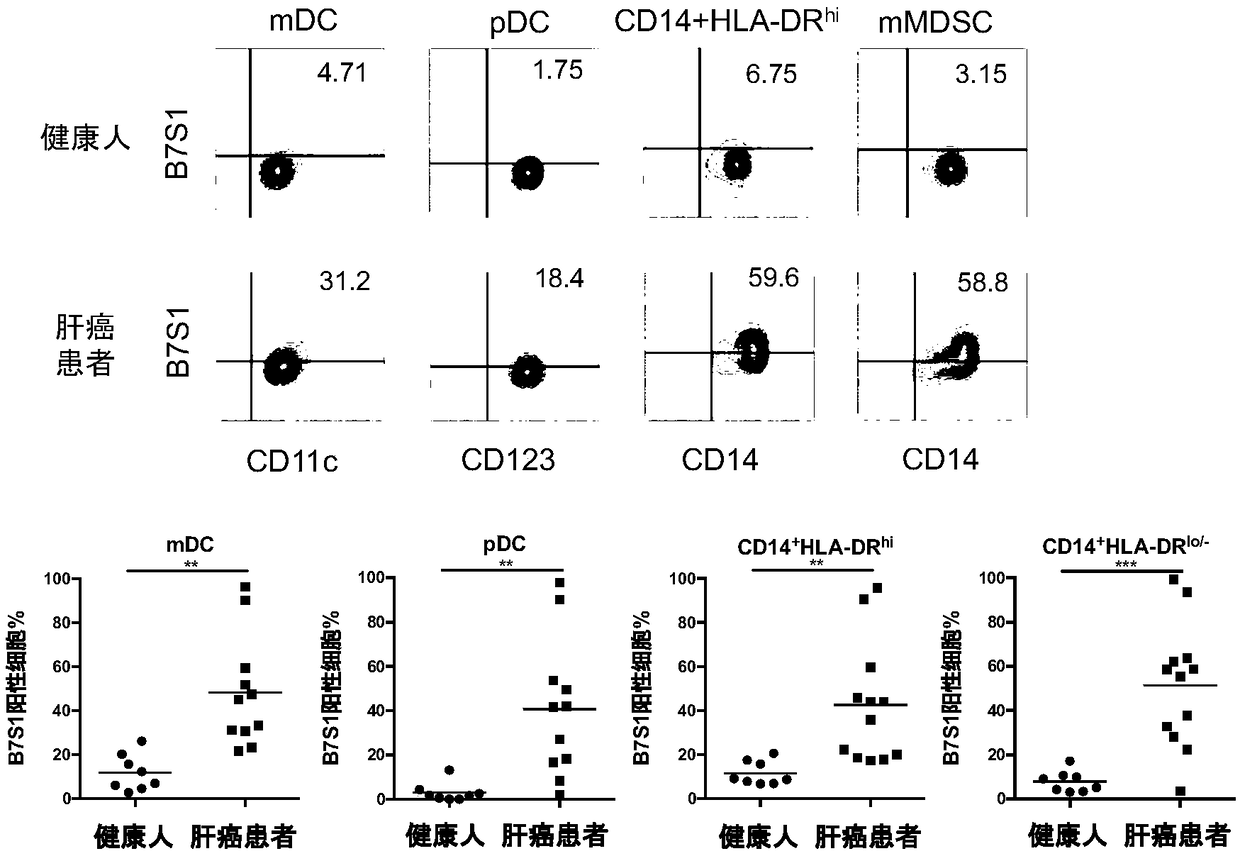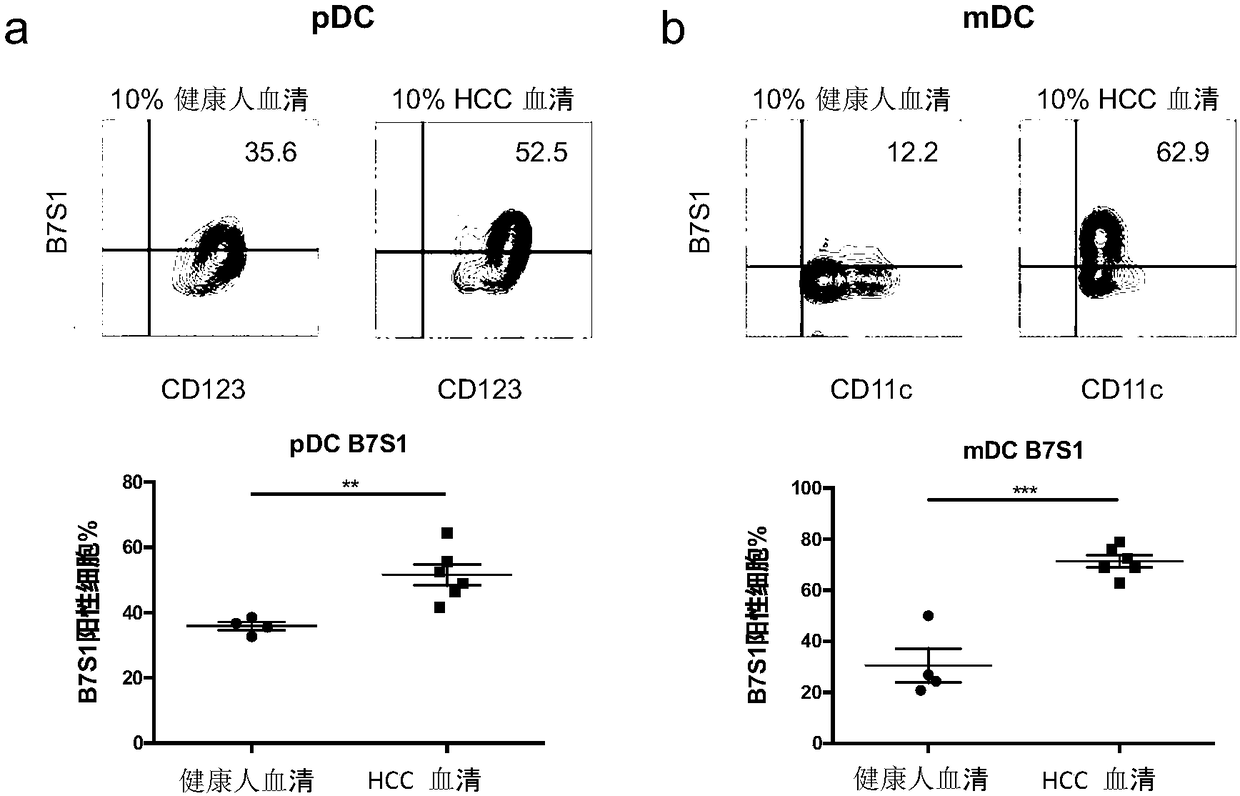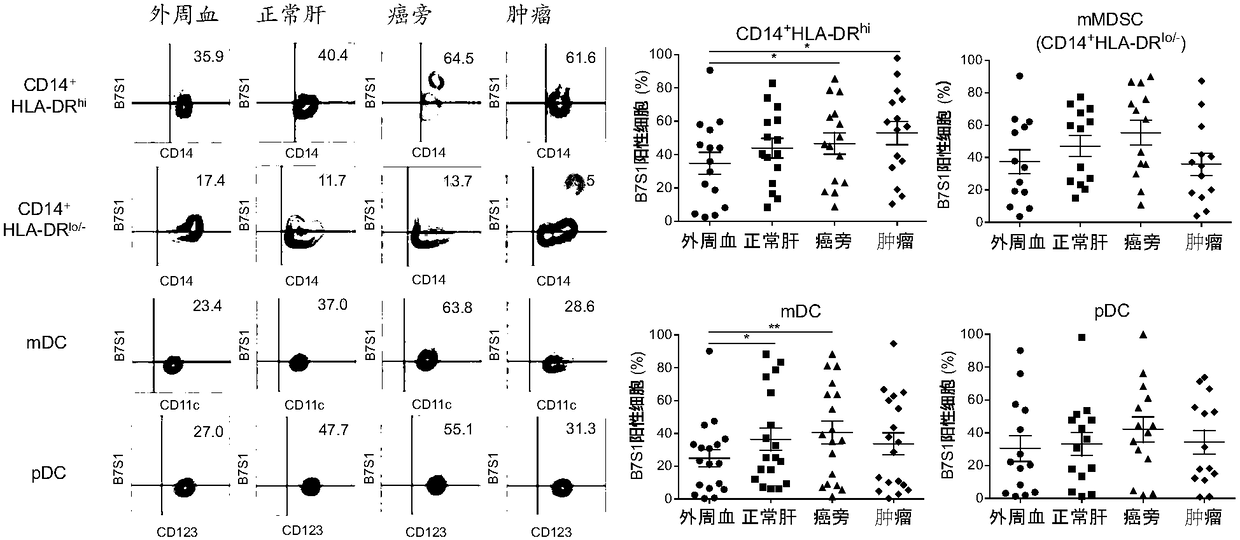Application of B7S1 (B7 family member 1) inhibitor in preparing liver cancer medicine
A 1.B7S1, liver cancer technology, applied in the field of biomedicine, can solve the problem of low cure rate of liver cancer
- Summary
- Abstract
- Description
- Claims
- Application Information
AI Technical Summary
Problems solved by technology
Method used
Image
Examples
Embodiment 1
[0087] Example 1 Blocking B7S1 signaling can inhibit the progression of liver cancer
[0088] In order to explore the possibility of B7S1 as a potential target for tumor immunotherapy, the inventors first analyzed the expression of B7S1 in peripheral blood and tissues of patients with hepatocellular carcinoma (Hepatocellular Carcinoma, HCC). According to the difference of cell surface markers, the inventors can circle myeloid dendritic cells (myeloid dendritic cell, mDC, Lin - HLA-DR hi CD11c + CD123 - ), plasmacytoid dendritic cell (plasmacytoid dendritic cell, pDC, Lin - HLA-DR hi CD11c - CD123 + ), CD14 + HLA-DR hi Monocyte or macrophage precursor, monocytic myeloid-derived suppressor cell (mMDSC, CD14 + HLA-DR low / - ) and other four different antigen-presenting cells. The results of flow cytometry analysis showed that the expression levels of B7S1 on the four myeloid antigen-presenting cells in the peripheral blood of HCC patients were significantly higher than ...
Embodiment 2
[0092] Example 2 Blocking B7S1 Signal Can Enhance CTL Activity
[0093] In the Hepa1-6 mouse model, although CD8 in B7S1 knockout mice + The percentage of TIL did not change ( Figure 14 , CD8 in the spleen, distal lymph nodes, tumor-draining lymph nodes, and tumors of wild-type and knockout mice + T, CD4 + The percentage of T cells in T cells and Treg in CD4 + percentage of T cells. SPL, spleen; LN, distal lymph node; TDLN, tumor-draining lymph node; TIL, tumor. WT, wild-type mice; KO, B7S1 knockout mice. ***p+ Increased expression of CD107a on the surface of TIL cells, upregulated expression levels of Granzyme B and perforin, and stimulation of CD8 by PMA / ionomycin + After TIL cells, the expression level of IFN-γ was up-regulated (results see Figure 15 , using flow cytometry to detect CD8 in tumors of WT and KO mice + The expression level of CD107a on the membrane surface of T cells and the expression levels of Granzyme B, perforin and IFN-γ after being stimulated b...
Embodiment 3
[0094] Example 3 Simultaneous blocking of B7S1 and PD-1 pathways can synergistically enhance anti-tumor immune responses
[0095]The inventors subcutaneously inoculated the Hepa1-6 mouse model on the 9th day and intraperitoneally injected Rat IgG+HamsterIgG, B7S1 antagonist+Hamster IgG, Rat IgG+anti-PD-1 (J43) or B7S1 antagonist+anti- PD-1, to compare the tumor suppressor effects of B7S1 antagonists, anti-PD-1 alone and in combination. The experimental results showed that the combination of B7S1 antagonist and anti-PD-1 had a stronger inhibitory effect on Hepa1-6 tumor growth than B7S1 antagonist or anti-PD-1 monotherapy.
PUM
 Login to View More
Login to View More Abstract
Description
Claims
Application Information
 Login to View More
Login to View More - R&D
- Intellectual Property
- Life Sciences
- Materials
- Tech Scout
- Unparalleled Data Quality
- Higher Quality Content
- 60% Fewer Hallucinations
Browse by: Latest US Patents, China's latest patents, Technical Efficacy Thesaurus, Application Domain, Technology Topic, Popular Technical Reports.
© 2025 PatSnap. All rights reserved.Legal|Privacy policy|Modern Slavery Act Transparency Statement|Sitemap|About US| Contact US: help@patsnap.com



